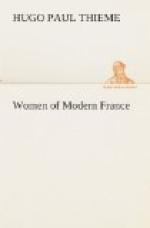In studying the vast numbers of salons of the eighteenth century, three types are discernible, each of which was prominent and in full sway throughout the century up to the Revolution. To the first class belong the great literary and philosophical salons which, though not political in nature, finally changed politics; such were the circles of Mme. de Tencin, Mme. Geoffrin, Mme. du Deffand, Mlle. de Lespinasse, Mme. Necker, Mme. d’Epinay, Mme. de Genlis; with these every literary student is familiar. The second class includes the smaller and less important literary, philosophical, and social salons—those of Mme. de Marchais, Mme. de Persan, Mme. de Villars, Mme. de Vaines, and of D’Alembert, D’Holbach, Helvetius. The third class is of a social nature exclusively, good breeding and good tone being the essentials; its conspicuous features were the dinners and suppers of Suard, Saurin, the Abbes Raynal and Morellet, of the Palais-Royal of Mme. de Blot, of the Temple of the Prince of Conti, those of Mme. de Beauvau, Mme. de Gramont, M. de La Popeliniere, and others.
The distinctions thus made will not hold throughout, but they facilitate the presentation of a subject that is exceedingly complicated. It may almost be said that each generation of the eighteenth century had a salon with a different physiognomy; those of 1710, 1730, 1760, and 1780 were all inspired by different motives, causes, and events, and were all led by women of different histories and aspirations, whose common idol was man, but whose ideas of what constituted a hero were as widely different as was the constitution of society in the respective periods. Not until the middle of the reign of Louis XIV. did social life become detached from Versailles, and, spreading out and circulating in a thousand hotels, showed itself in all its force, splendor, and elegance. The celebrated women of the regency—Mme. de Prie, Mme. de Parabere, Mme. de Sabran—had no salon, while those of the Marquis d’Alluys and the Hotels de Sully, de Duras, de Villars, and the suppers of Mme. de Chauvelin were of a distinctly different type from those of the earlier and the later periods.
In a certain sense, the salons changed the complexion of the age. The eighteenth century itself was friendly and generous; it was, also, impatient and inexperienced, seeing things not as they were but as it wished them to be, compelling science and art to serve its purpose. It was frank, often brutally frank, a characteristic due partly to the conversational license of the salons. With its Fontenelle, Voltaire, Piron, etc., it was indeed a happy century. A bon mot was the event of the day and travelled over all the civilized world.




